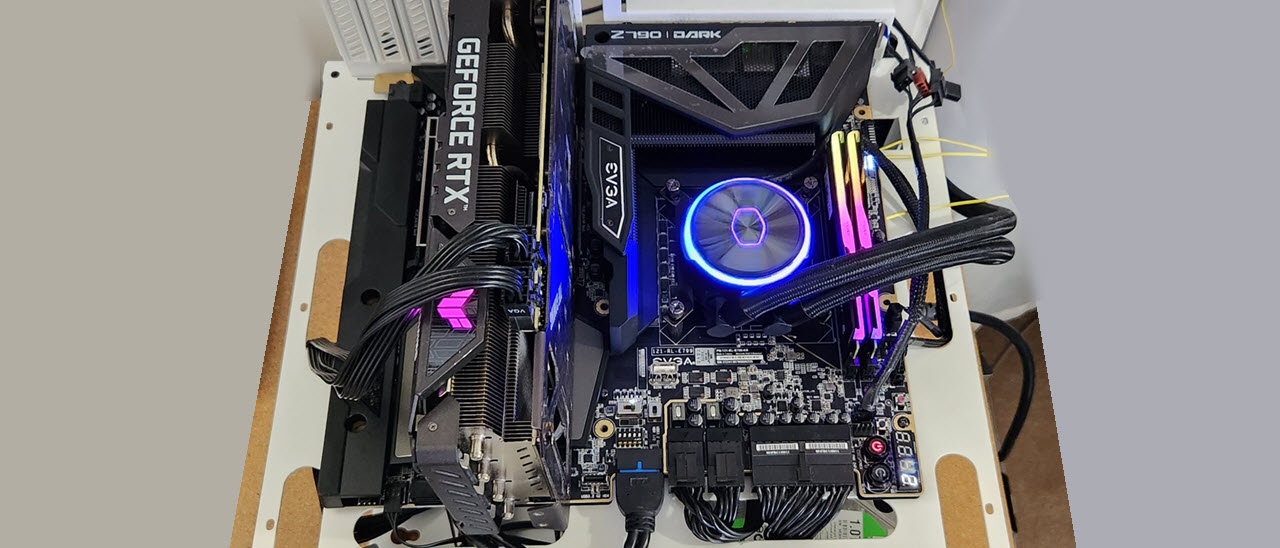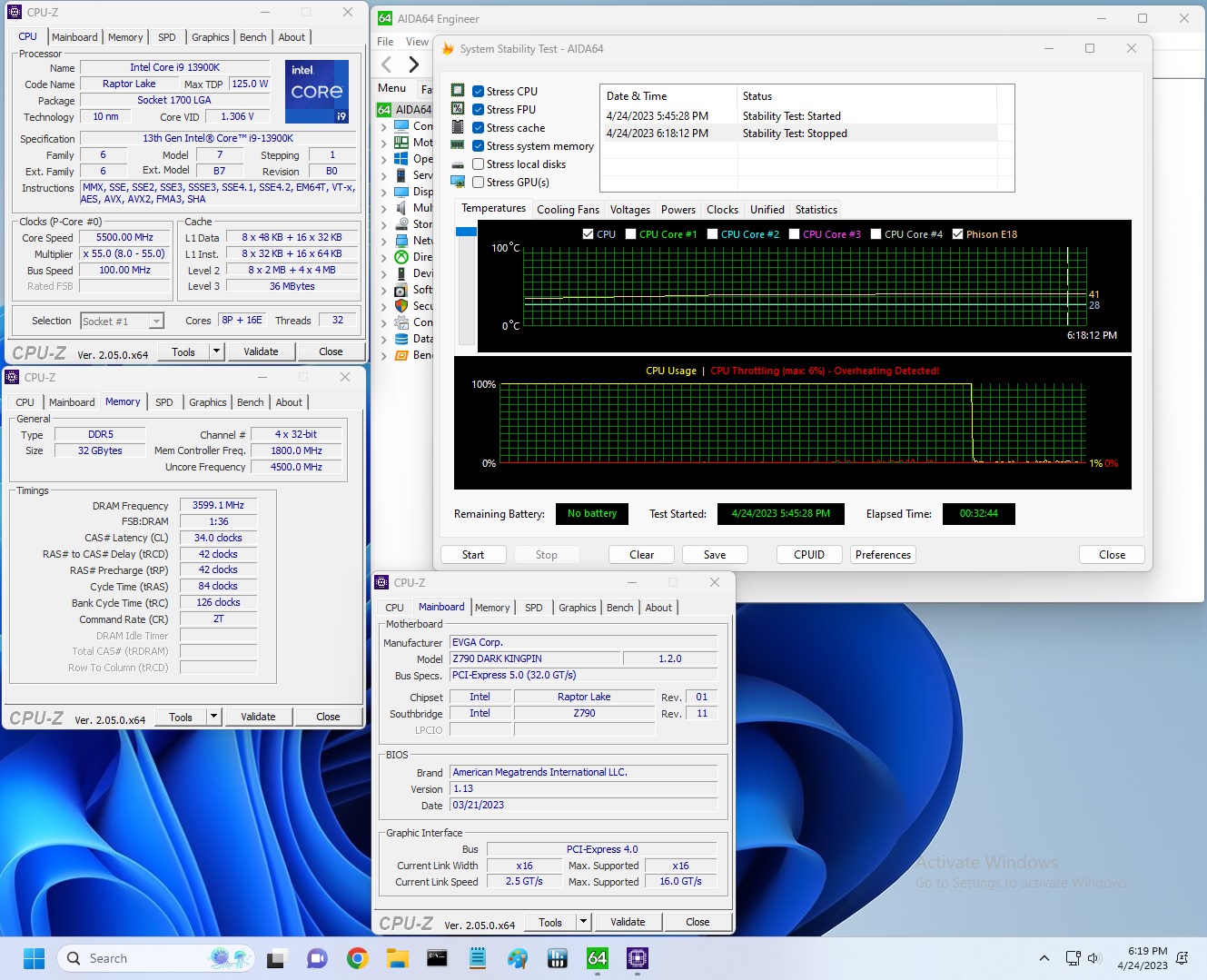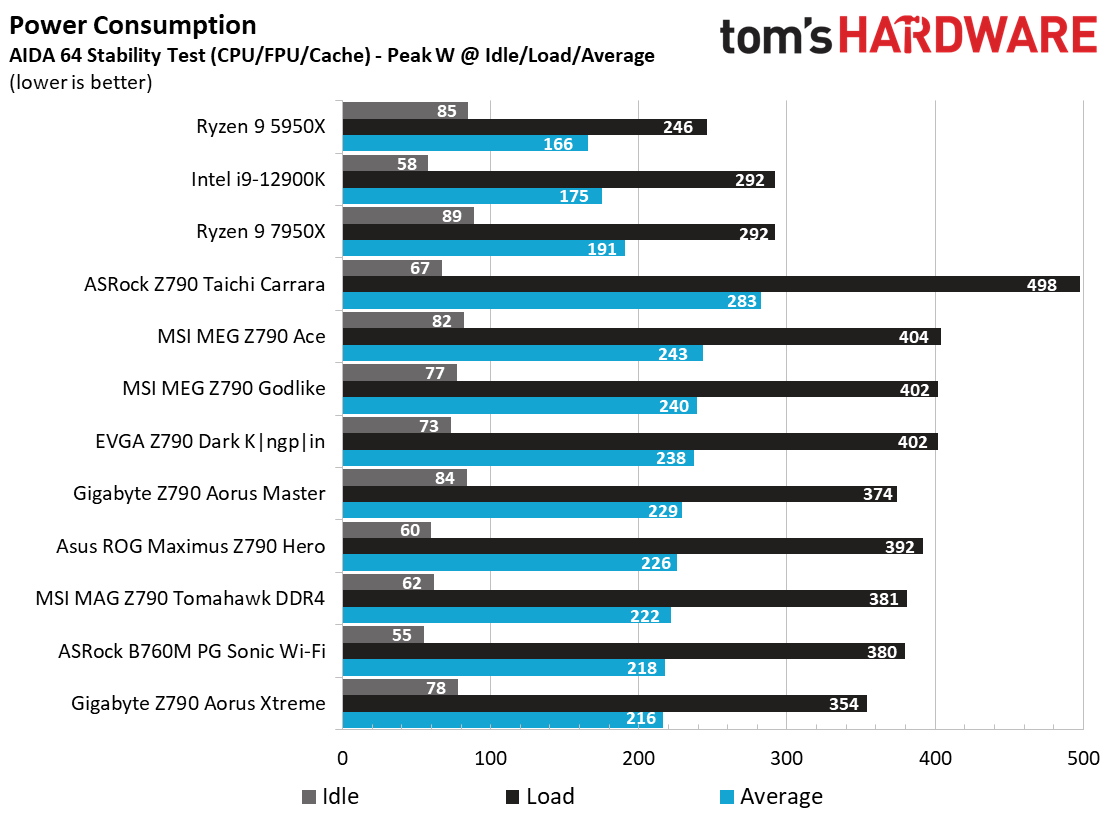Why you can trust Tom's Hardware
Benchmark Results
Our standard benchmarks and power tests are performed using the CPU’s stock frequencies (including any default boost/turbo), with all power-saving features enabled. We set optimized defaults in the BIOS and the memory by enabling the XMP profile. For this baseline testing, the Windows power scheme is set to Balanced (default) so the PC idles appropriately.
Synthetic Benchmarks
Synthetics provide a great way to determine how a board runs, as identical settings should produce similar performance results. Turbo boost wattage and advanced memory timings are places where motherboard makers can still optimize for either stability or performance, though, and those settings can impact some testing.
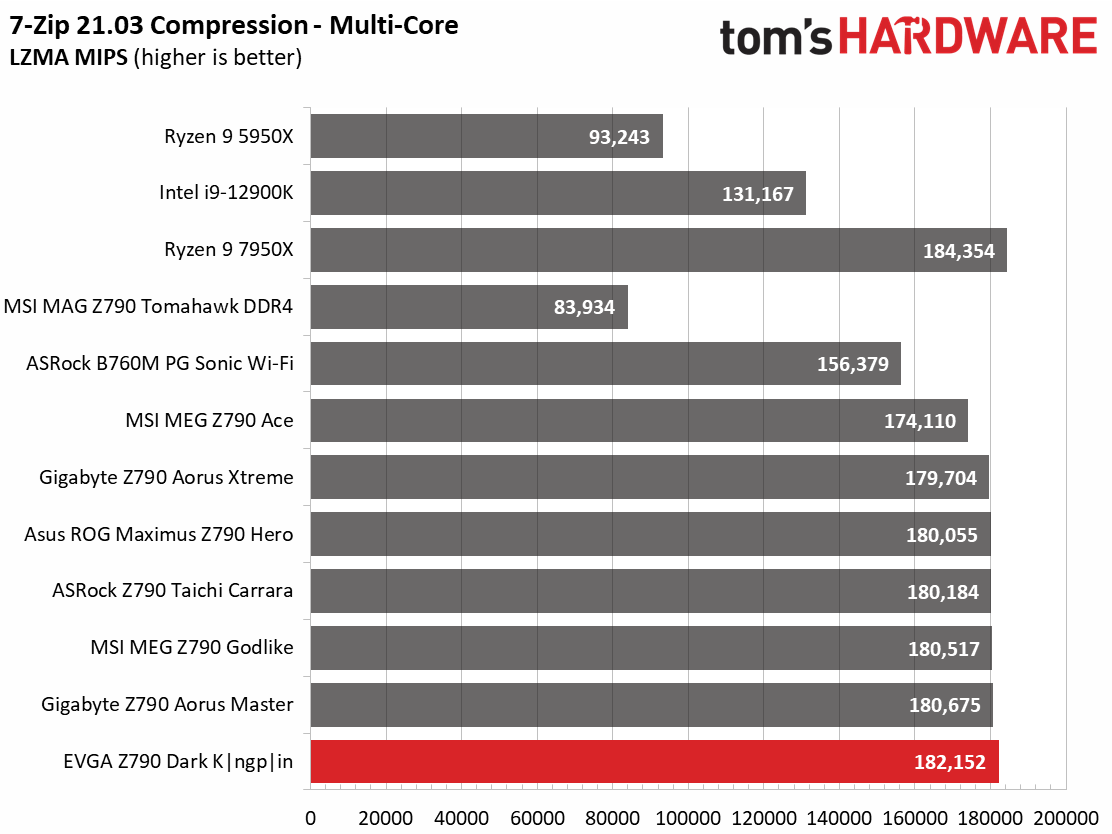
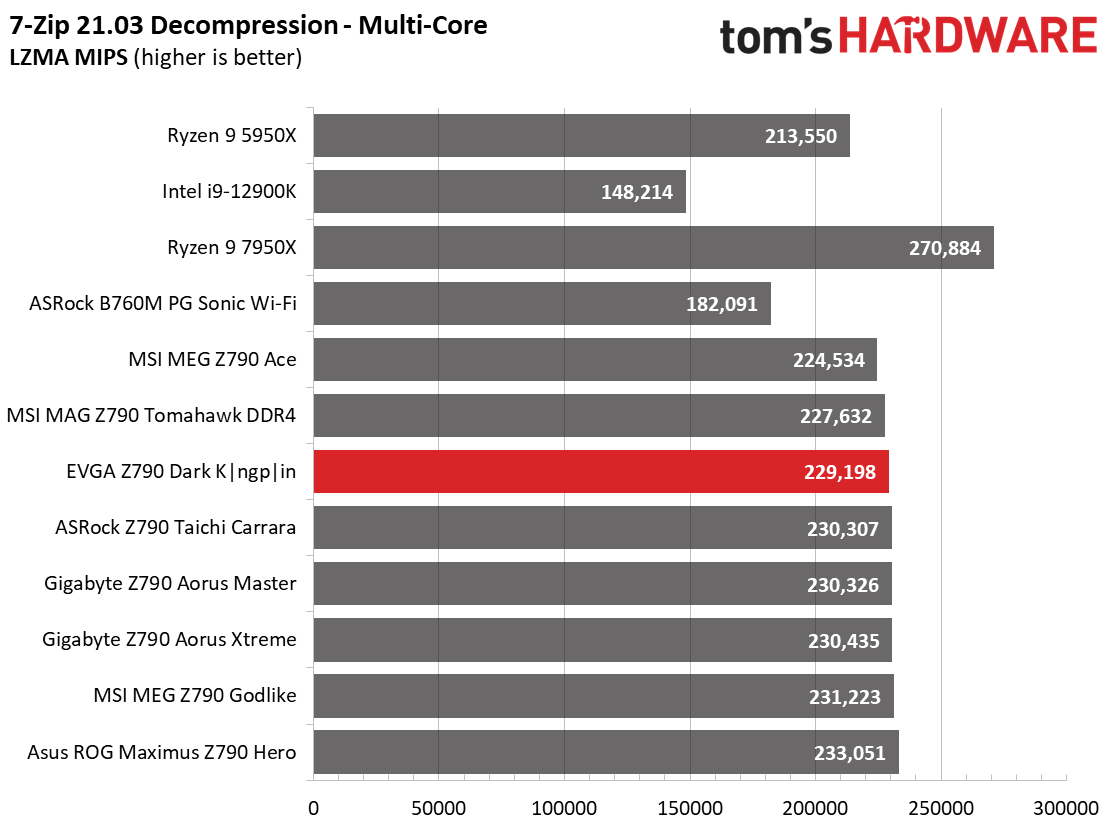
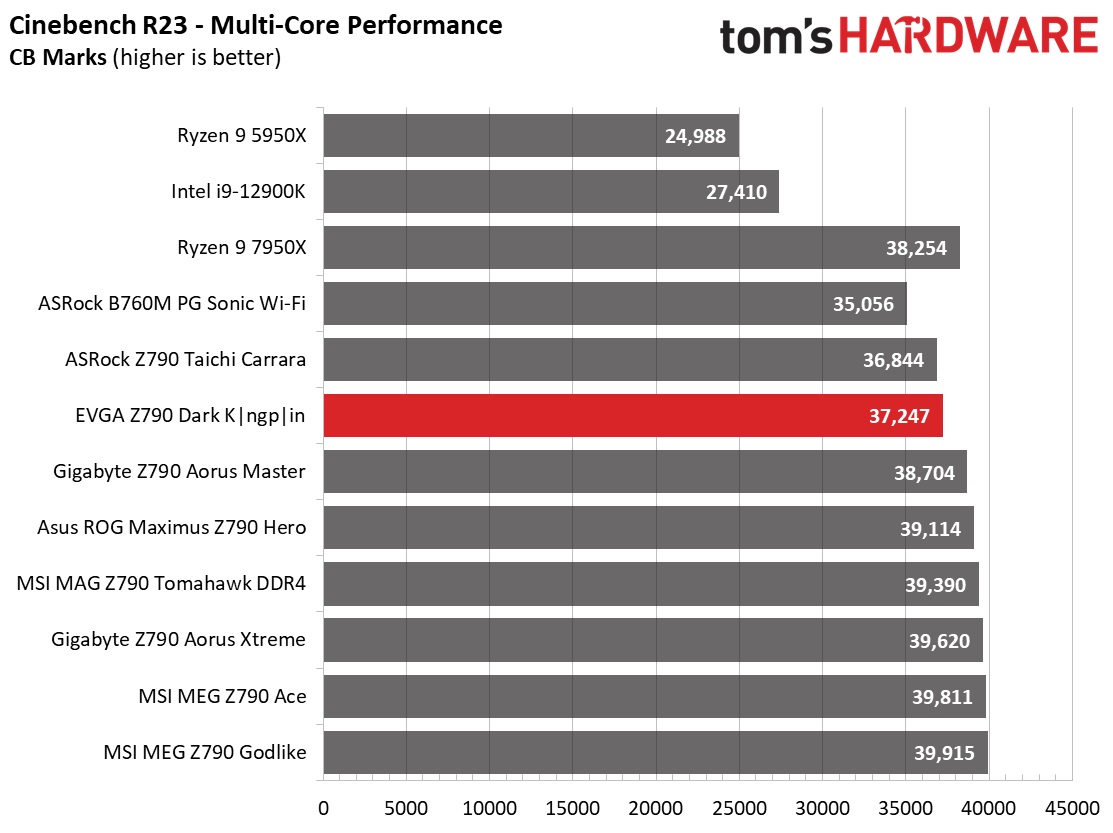
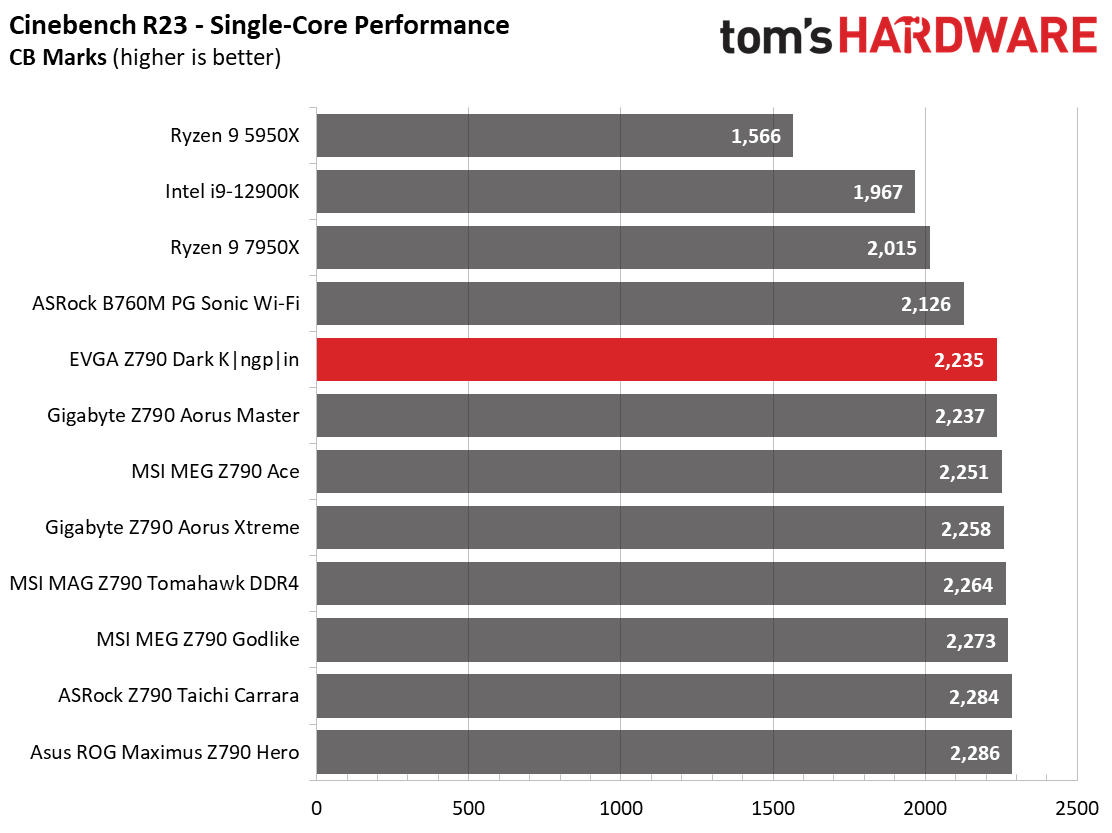
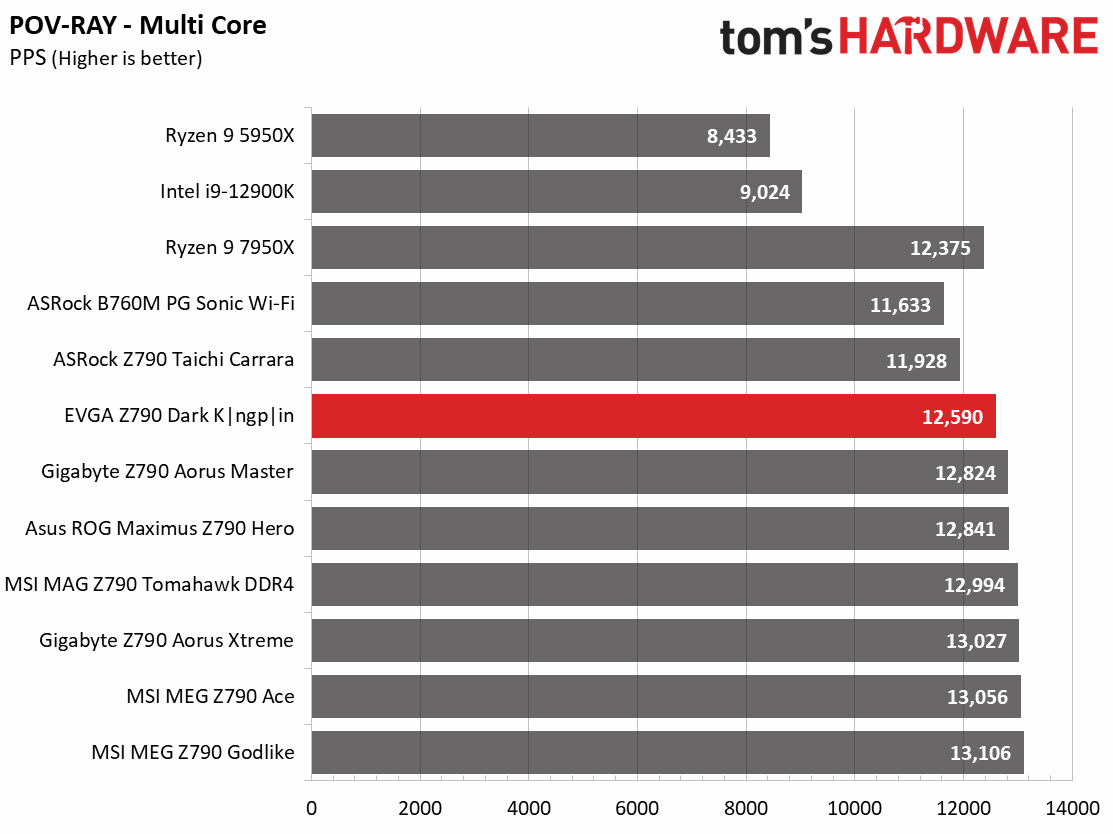
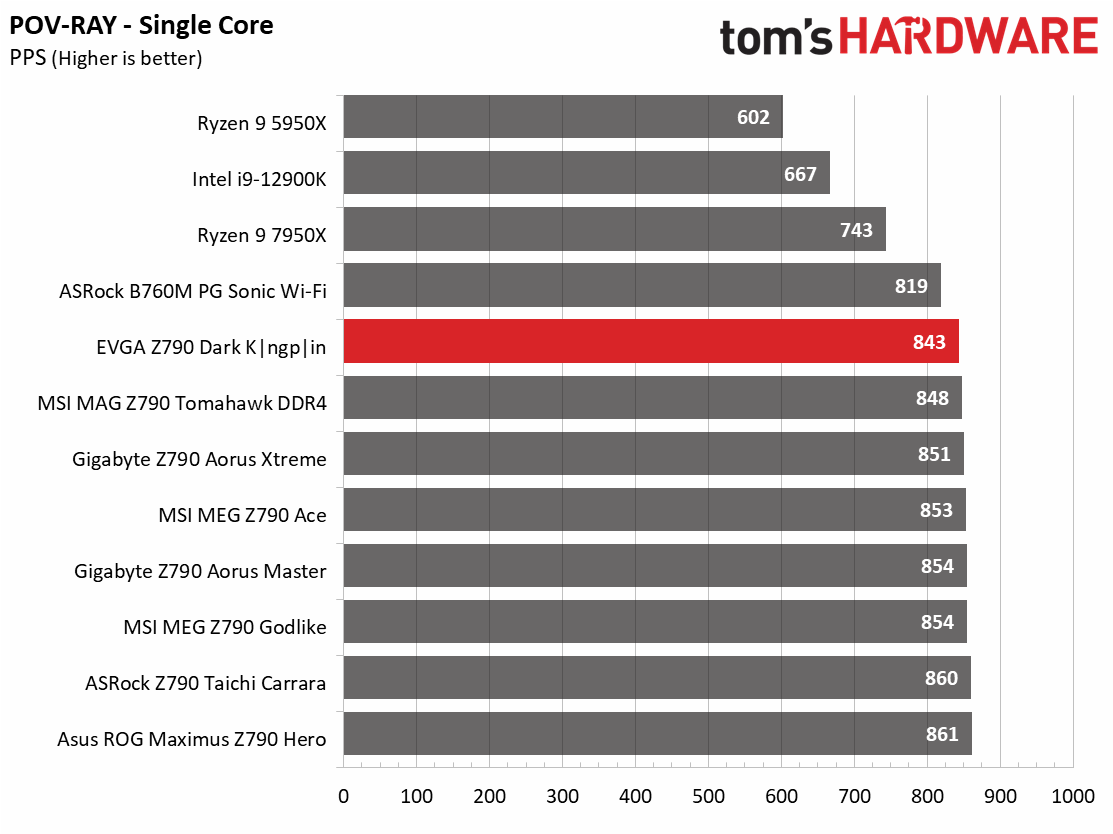
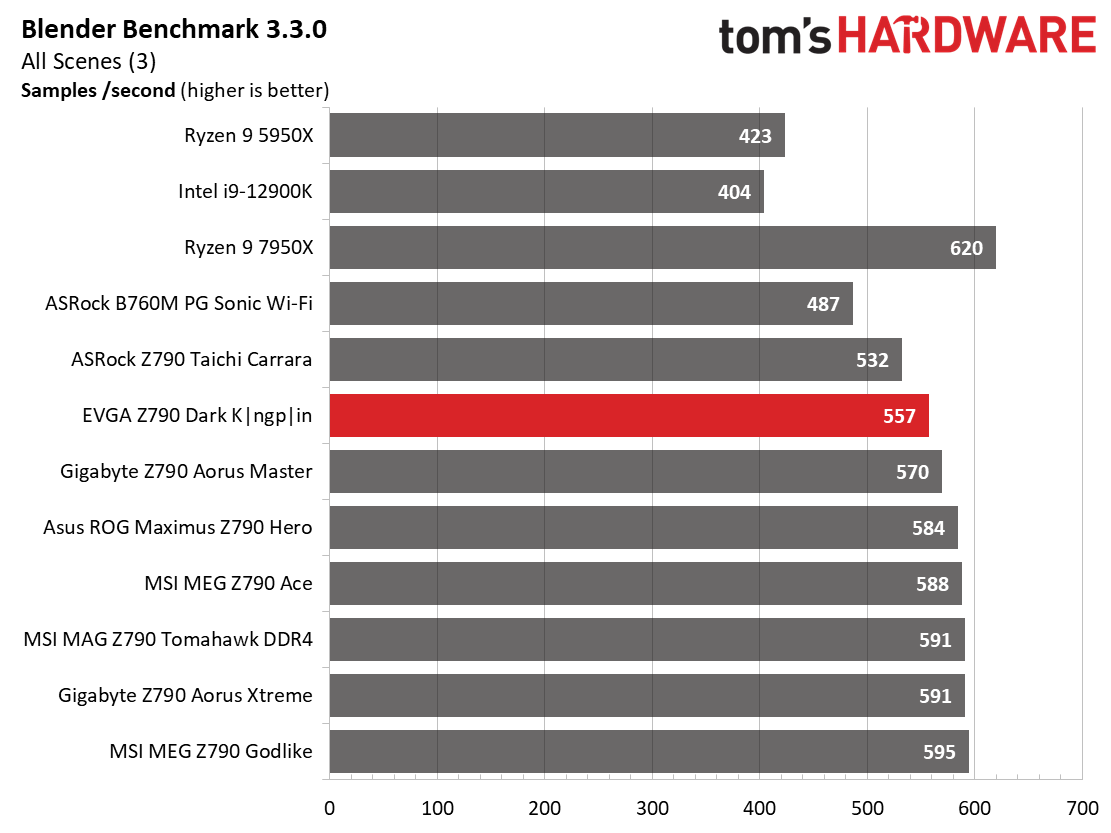
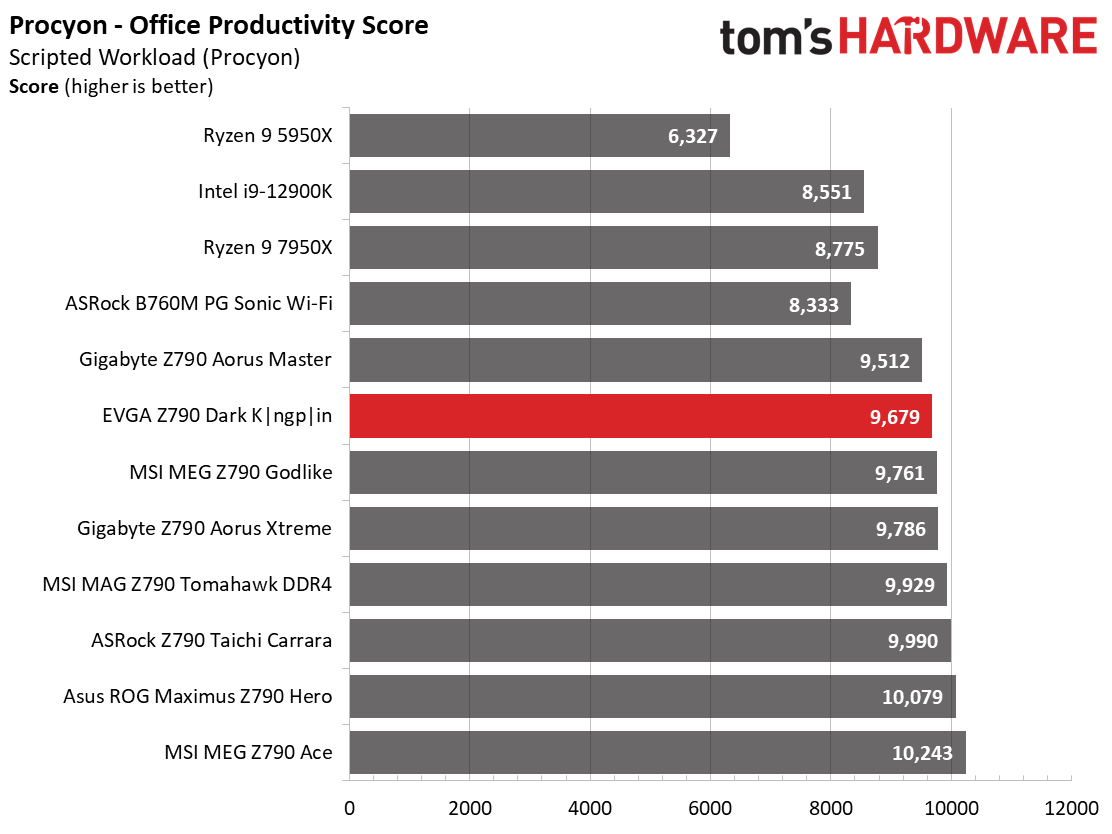
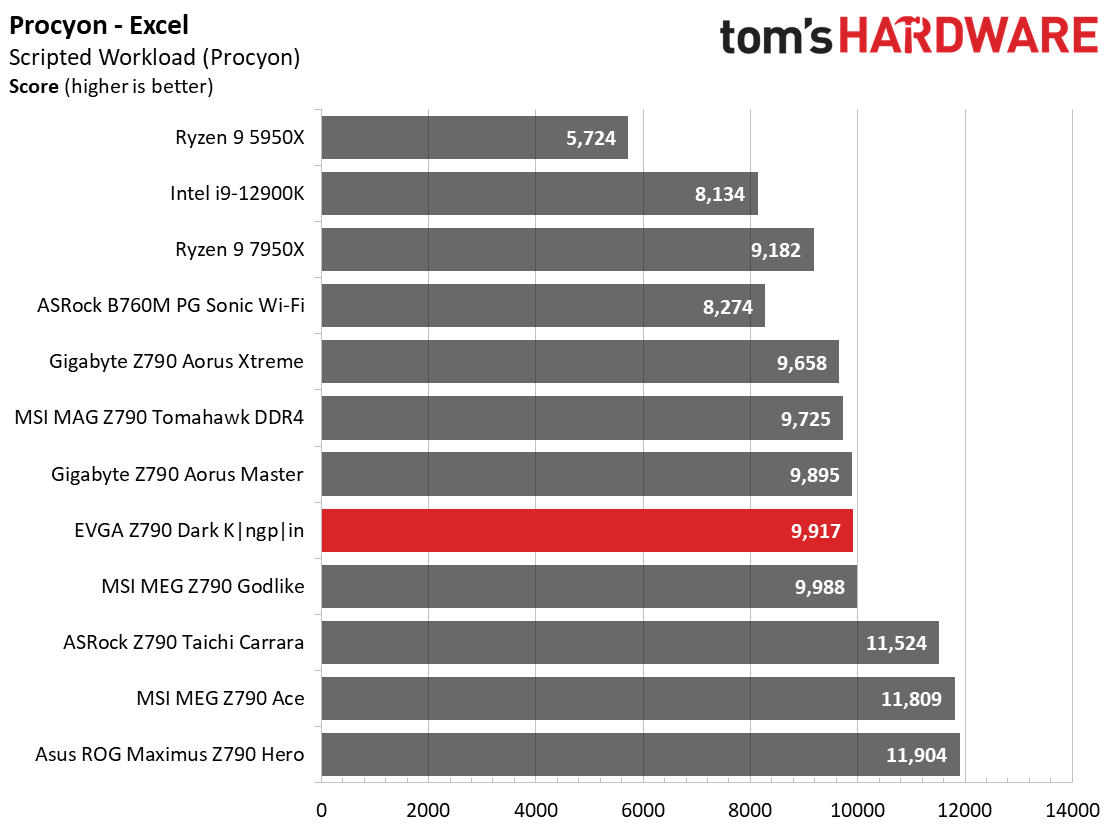
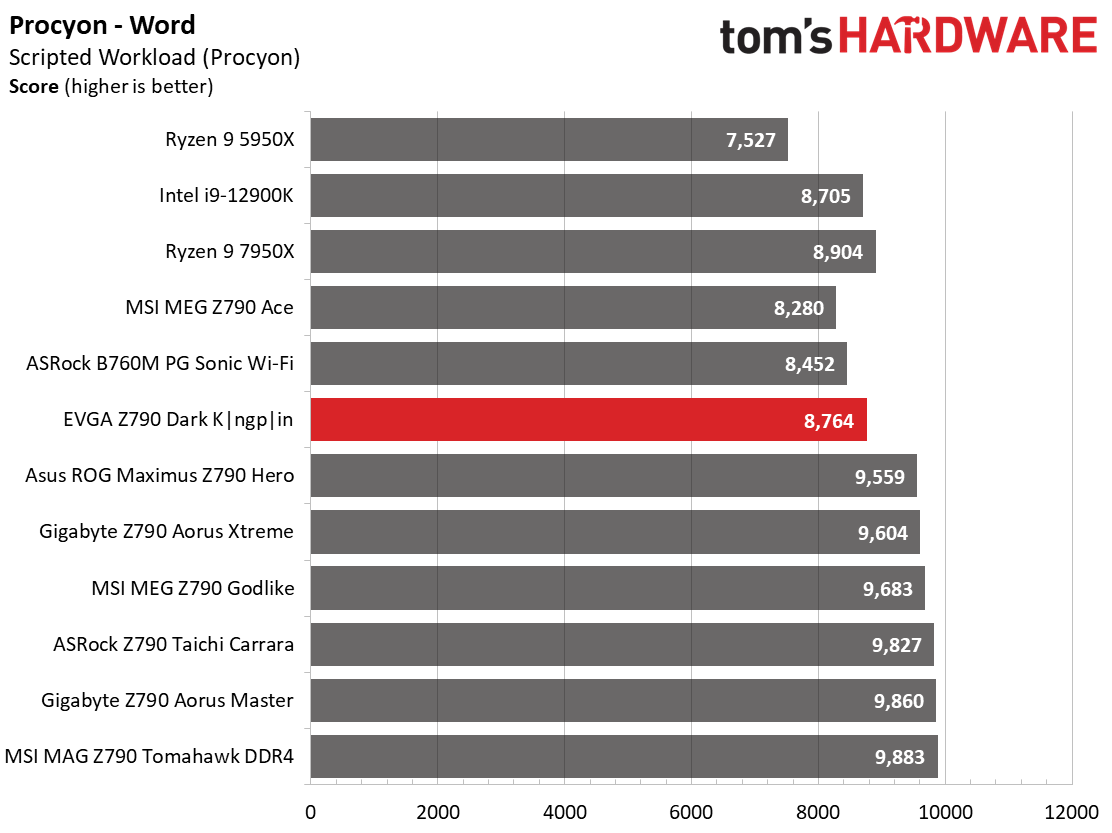
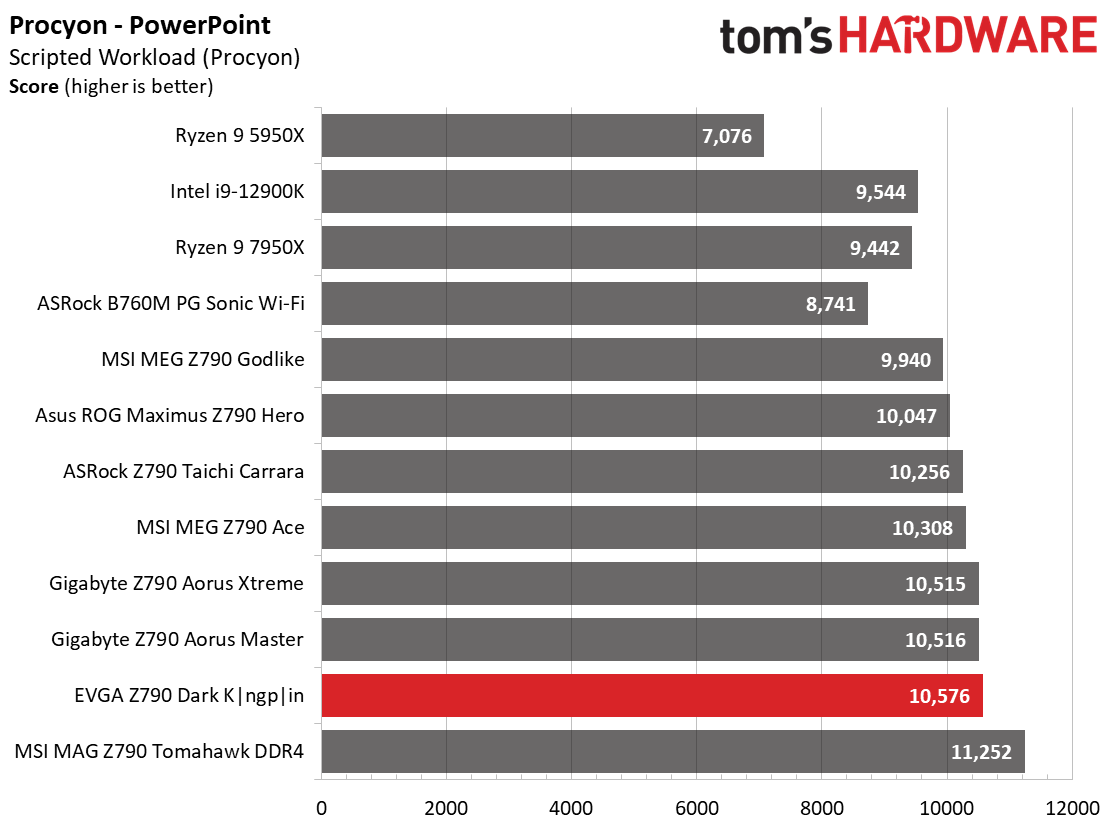
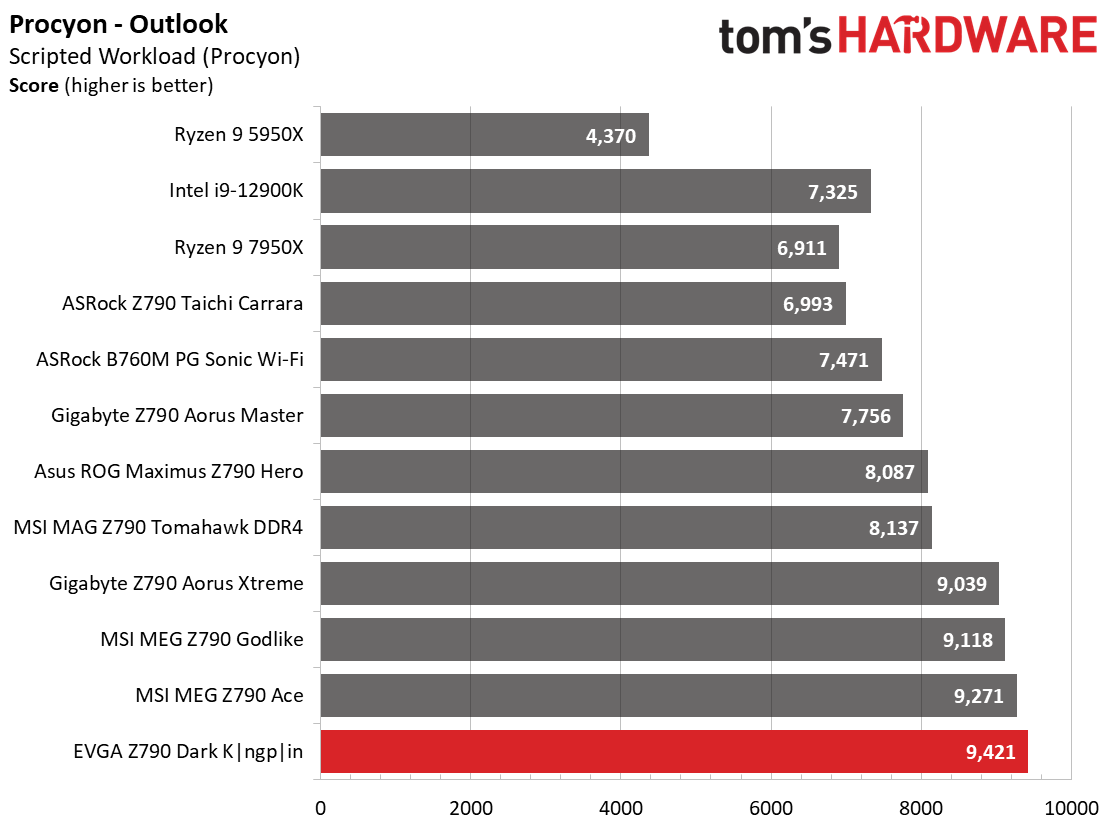
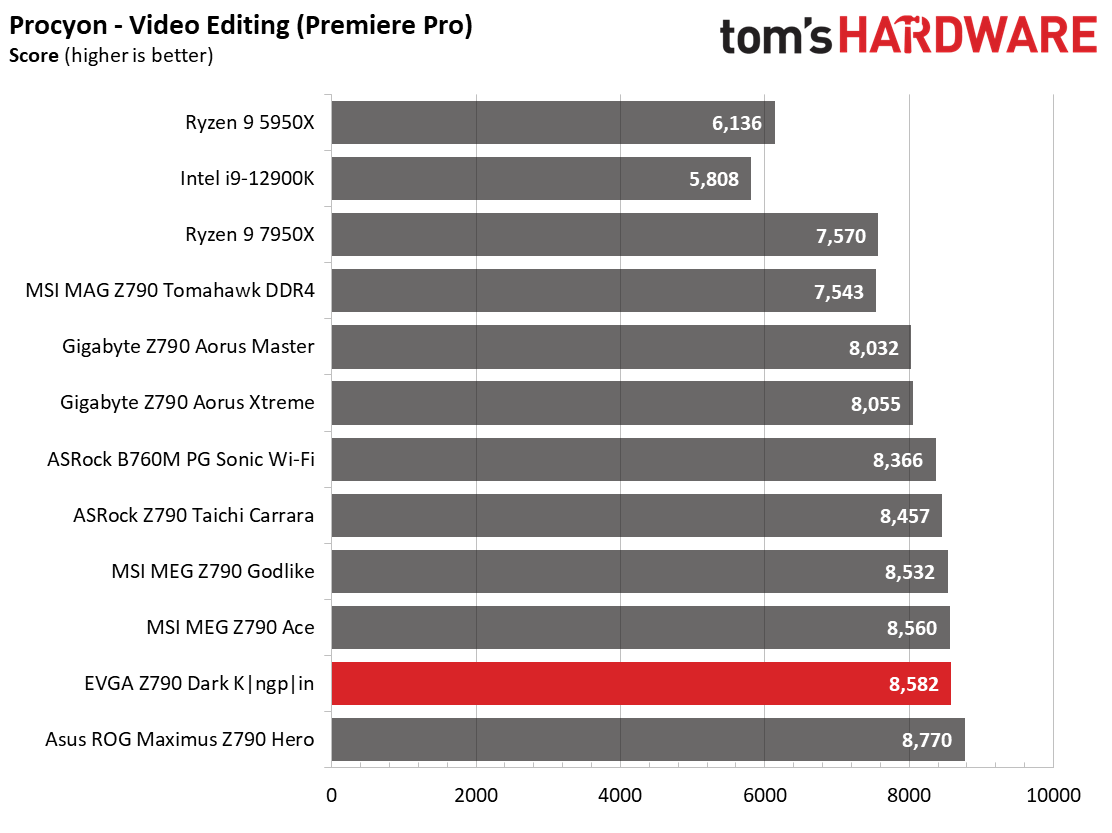
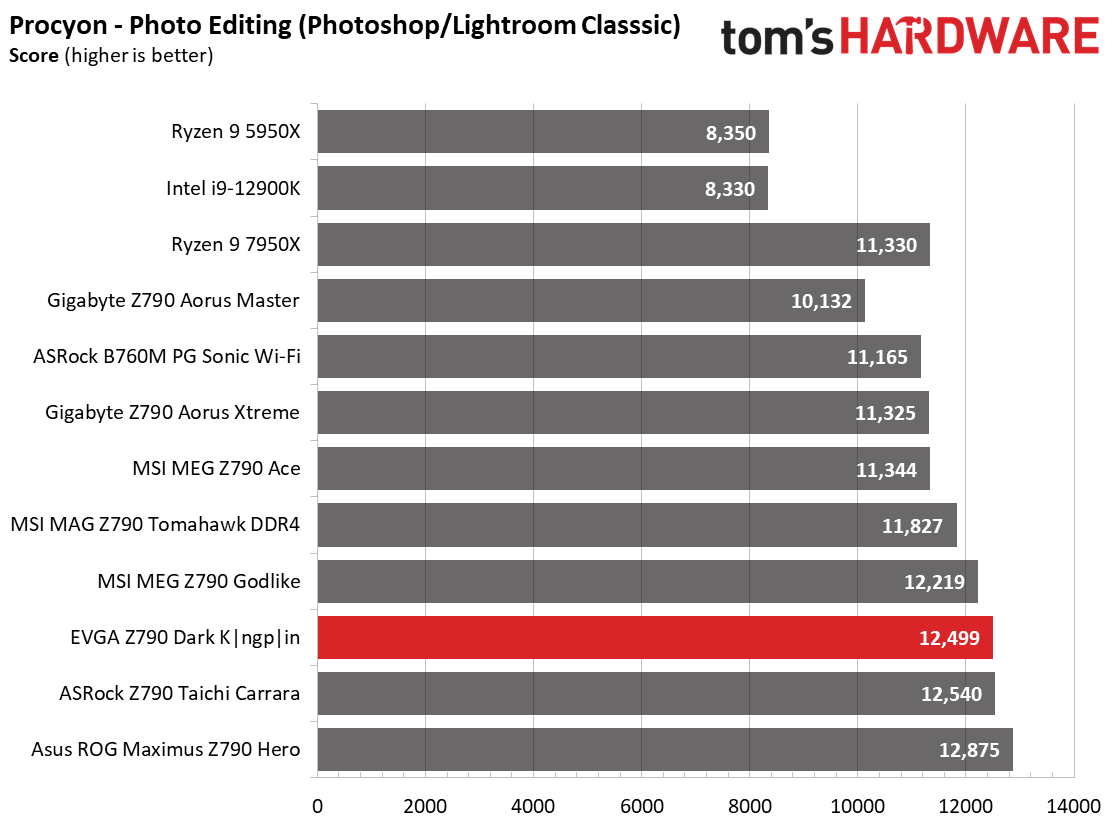
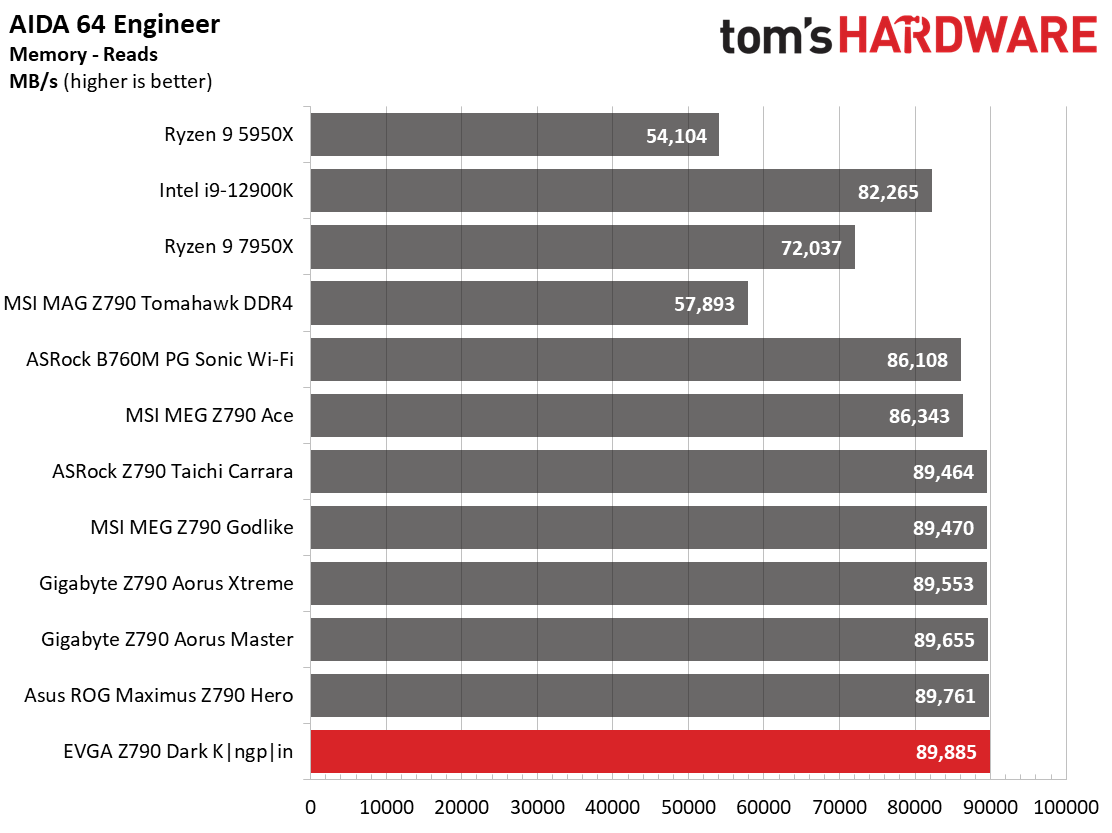

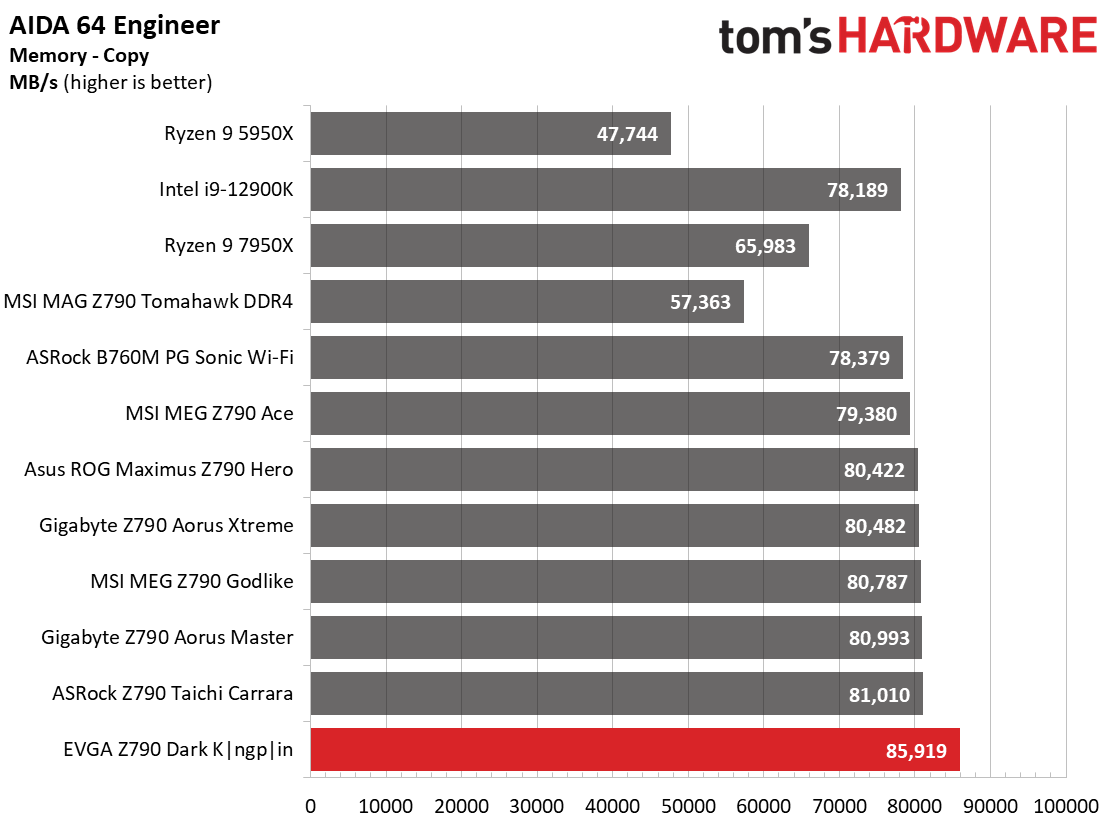
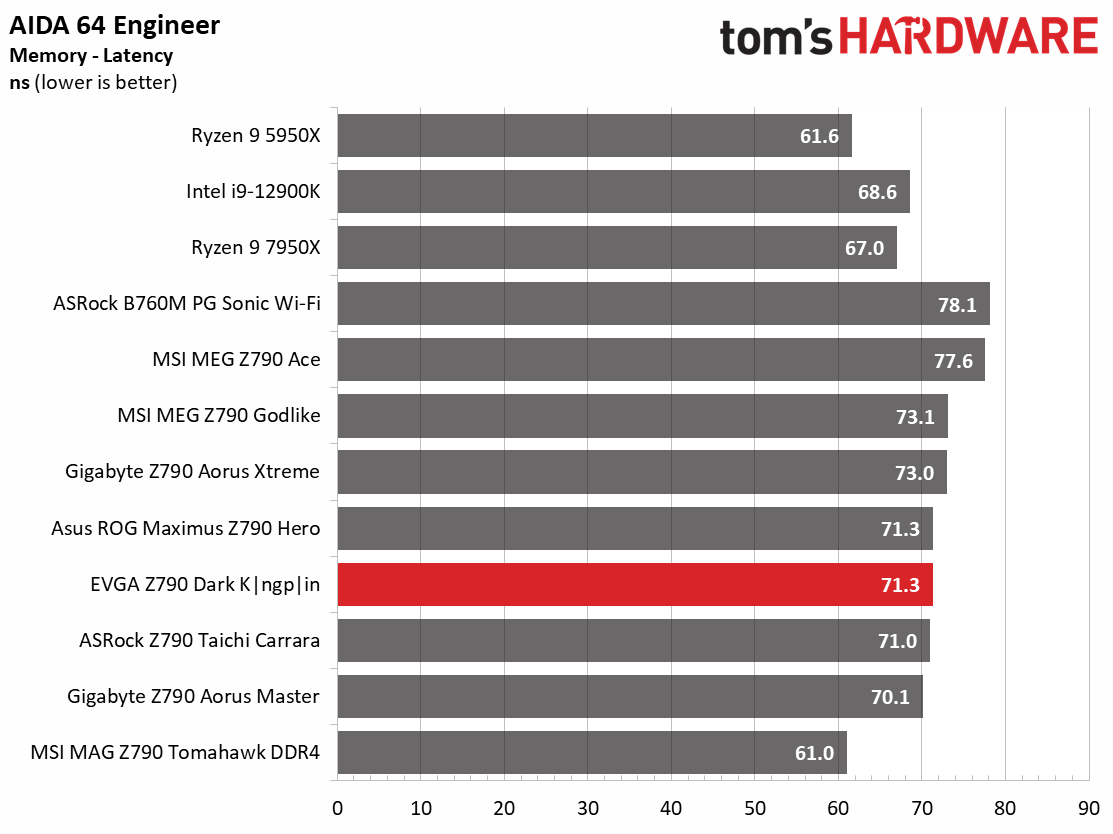
Across our synthetic benchmarks, the Z790 Dark performed well overall. It was a bit slower than average in Cinebench and POV–Ray multi-threaded, but it did well in the Procyon tests (Office and Video/Photo editing) and exceedingly well in RAM bandwidth. Like with any modern board and CPU, if you keep temperatures in order/not throttling, you’ll get better performance.
Timed Applications
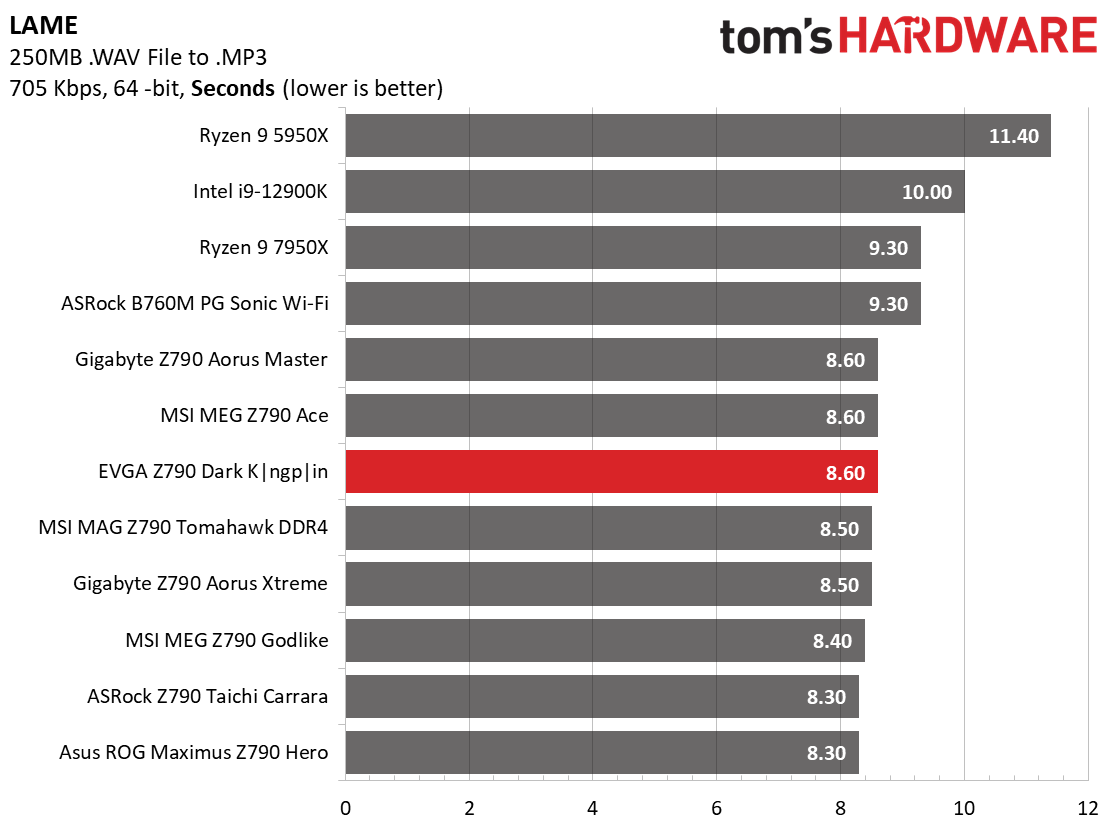

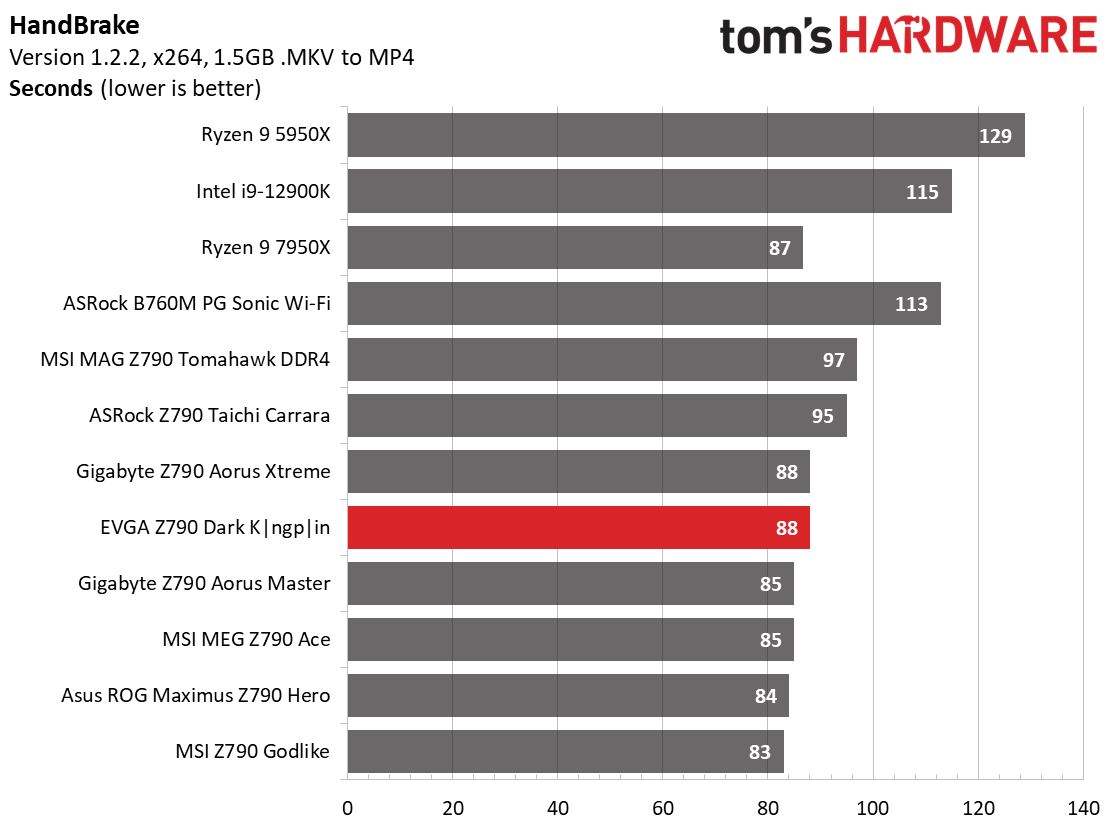

In the timed applications, the Z790 Dark was above average in Corona, average in LAME, and both Handbrake tests. There’s nothing to worry about in these applications!
3D Games and 3DMark
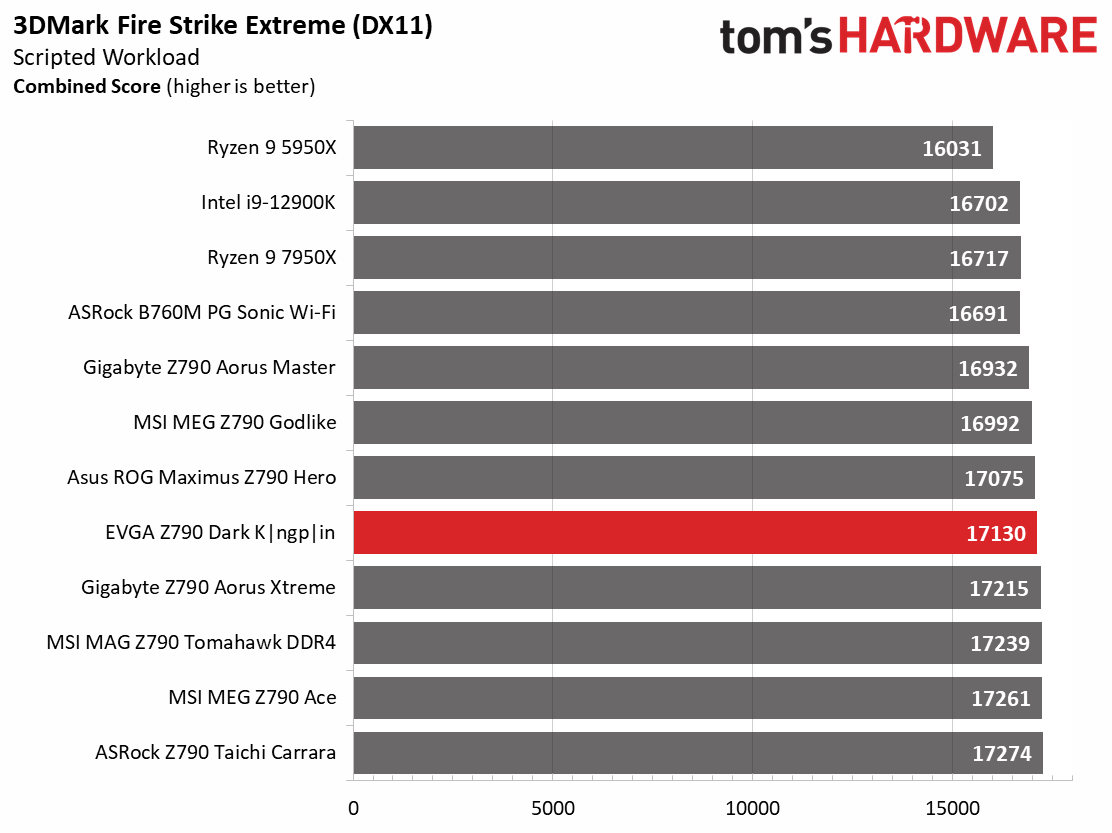
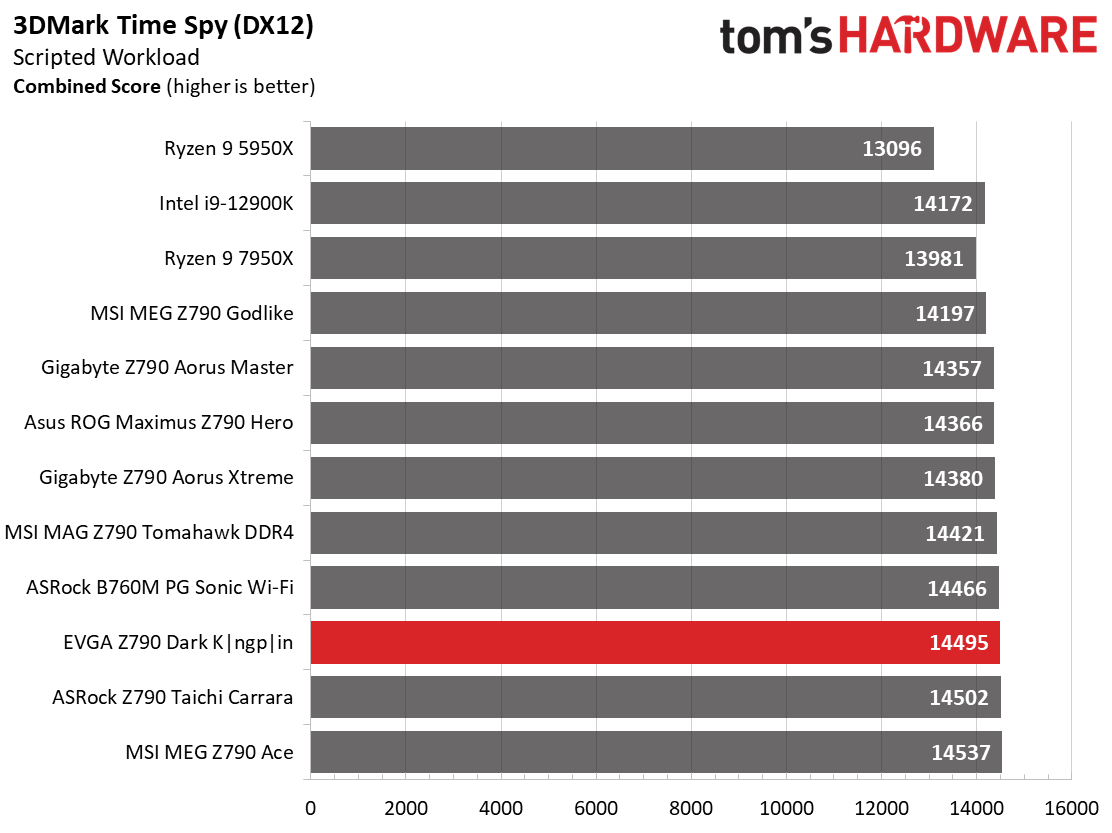
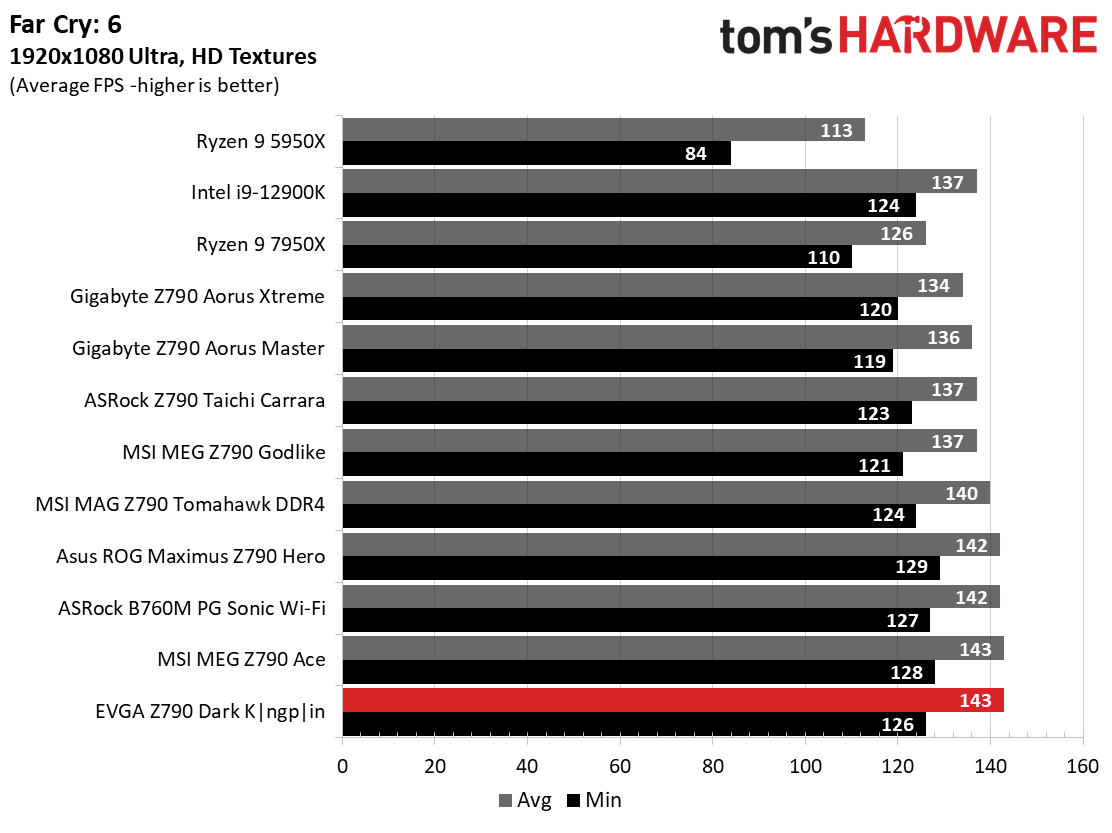
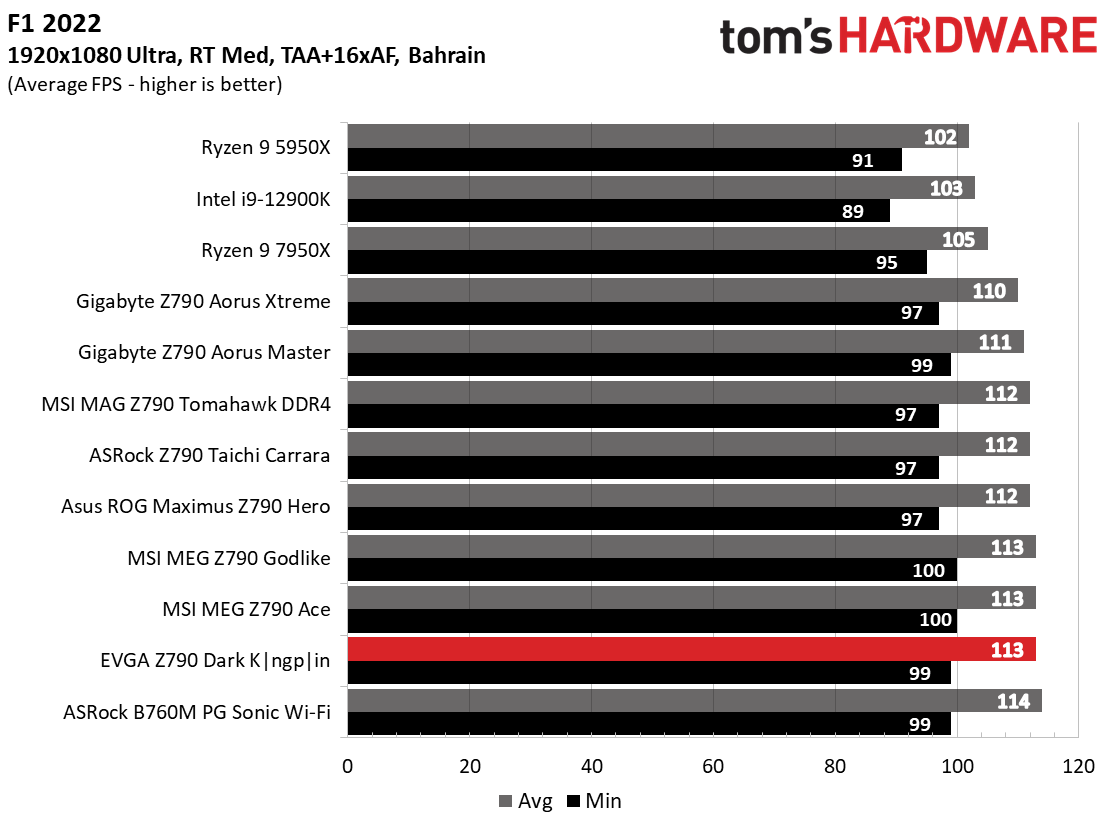
Starting with the launch of AMD’s Ryzen 7000 platform, we’ve updated one of our games, F1 21 to F1 22, while keeping Far Cry 6. We run the games at 1920x1080 resolution using the Ultra preset (details listed above). As the resolution goes up, the CPU tends to have less impact. The goal with these settings is to determine if there are differences in performance at the most commonly used (and CPU/system bound) resolution with settings most people use or strive for (Ultra). We expect the difference between boards in these tests to be minor, with most falling within the margin of error differences. We’ve also added a minimum FPS value, which can affect your gameplay and immersion experience.
To be succinct, the Z790 Dark is a competent gaming board. The 3DMark results were around the average, while the gaming tests showed our board up toward the top on average frames per second and average on minimums. You’d be hard-pressed to notice a difference without looking at a frame counter.
Overclocking
When overclocking, we aim to increase the power and add stress to the VRMs. We do so by increasing the clock speed and voltage until we’re at the thermal threshold for the processor during stress testing. However, where these CPUs are allowed to run with ‘boost’ speeds, those speeds are closer to the limit than ever before.
Get Tom's Hardware's best news and in-depth reviews, straight to your inbox.
With our i9-13900K, the approach was different. We had to lower the voltage from what we recorded during stress tests to overclock our chip. We increased the clock speeds of the “P” and “E” cores by 100 MHz and 200 MHz, respectively, over the turbo boost and limited by our cooling. We ended up with 5.6 GHz P core and 4.5 GHz E core clocks using about 1.34V (from DMM). Temperatures peak just under the throttling point with this configuration. And as we’ve noted elsewhere, this is the intended performance for Intel’s flagship CPU.
Overclocking on the Z790 Dark on ambient cooling was as easy as you’d expect. Like with past motherboards, we set 1.35V in the BIOS, and on the Dark, load voltage in Windows is close enough to what was set in the BIOS not to enable LLC (for our meager overclock). As expected, the VRMs didn’t flinch (remember we tend to use a bit LESS power overclocking to our clock speeds), and the board ran stably throughout testing.
Using the latest BIOS (v1.13 at this time), it was smooth sailing on the memory side, too—all three memory kits, up to DDR5-7200, worked by simply enabling the XMP profile. As always, your mileage may vary, as reaching these speeds depends on the memory kit, BIOS, and processor. Still, most combos should be able to reach DDR5-7200 speeds on the Intel platform.
Power Consumption / VRM Temperatures
We used AIDA64’s System Stability Test with Stress CPU, FPU, Cache and Memory enabled for power testing, using the peak power consumption value. The wattage reading is from the wall via a Kill-A-Watt meter to capture the entire PC (minus the monitor). The only variable that changes is the motherboard; all other parts remain the same. Please note we moved to use only the stock power use/VRM temperature charts, as this section aims to ensure the power delivery can handle the chip even when overclocked. Since we’re using less power to get more clocks, those datasets are more novel than useful. We’re also temperature limited on the processor, so adding more power isn’t possible without increased throttling.
Idle power consumption on the premium Z790 Dark sat around 73W and peaked at 402W under load. The idle and load values more or less match up with other high-end boards. There’s nothing out of line on power use, but the Dark does use more juice than the average (as is expected with a high-end motherboard).
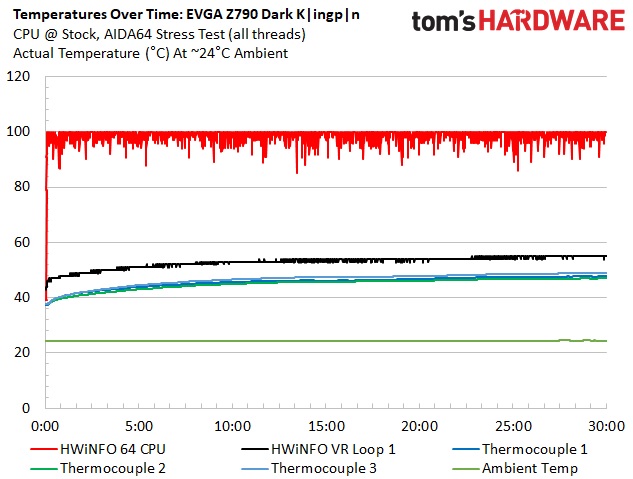
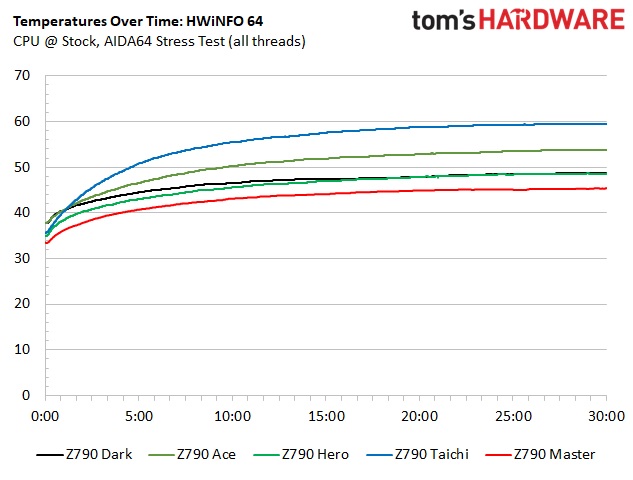
VRM temperatures on our board peaked at just under 49 degrees Celsius, a great result for a 400W load (at the wall). The temperatures are well within the specifications of the high-end 105A SPS MOSFETS, so there’s nothing to worry about here, no matter what kind of overclocking you’re doing.
Bottom Line
For those looking to get the most out of their processor and memory through overclocking, the Z790 Dark Kingpin is one of the best options available, especially if your overclocking adventures involve sub-ambient cooling methods. That said, it’s more than competent as a daily driver too. Hardware-wise, the only thing missing is a PCIe 5.0-capable M.2 socket. The board has overbuilt power delivery, three M.2 sockets, eight SATA ports, ample USB count on the rear IO (including a 20 Gbps Type-C port), dual NICs (2.5 and 10 GbE), and a premium (though last-gen) audio solution. Performance across our testing places this board as average to above average, depending on what test you’re looking at. It gamed well, showed promise in the Procyon test suite, and had the most memory bandwidth among its peers.
Regarding competition, you can group this with overclocking boards like the Gigabyte Z790 Tachyon ($599.99) and the Asus ROG Strix Z790 Apex ($699.99). You can also put it up against the flagships, and outside of a 40 Gbps port and PCIe 5.0 M.2 socket(s), it compares well specs-wise and is cheaper than some of those. Compared to its kind, the Z790 Dark holds up well on specs but does cost more at $799.99 (assuming you can find the Tachyon or Apex in stock). All of these boards will hold up to sub-ambient/extreme overclocking as they are built for it. Of these, only the Apex has a PCIe 5.0 M.2 socket. Otherwise, it’s PCIe 4.0 x4 sockets (of which the Apex has the most at five). Outside of that, the specs are similar enough among them. It’s going to come down to price and appearance.
Ultimately, we love what the EVGA Z790 Dark Kingpin has to offer. While the price is higher than its peers, it’s currently the only one you can find in stock anywhere close to MSRP. Availability aside, it has a unique appearance with the rotated socket area and black-on-gold theme that stands out inside your chassis. The horizontal ports and sockets around the edges, along with the notch, are there to help clean up the wires, something the Asus doesn’t have. In all, the Z790 Dark is a well-rounded but expensive option in the premium mid-range/high-end and overclocking spaces. It’s not a great value among Z790 motherboards, but it is one of the more unique, capable, and overbuilt of the bunch.
MORE: Best Motherboards
MORE: How To Choose A Motherboard
MORE: All Motherboard Content

Joe Shields is a staff writer at Tom’s Hardware. He reviews motherboards and PC components.
-
HideOut $800 and no PCIe 5.0? are they KIDDING!Reply
In related news, if you buy from the provided link THG gets money from your purchase. No pressure.
